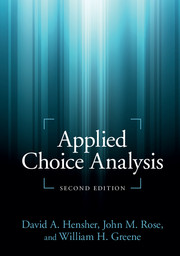Book contents
- Frontmatter
- Contents
- List of Figures
- List of Tables
- Preface
- Part I Getting started
- 1 In the beginning
- 2 Choosing
- 3 Choice and utility
- 4 Families of discrete choice models
- 5 Estimating discrete choice models
- 6 Experimental design and choice experiments
- 7 Statistical inference
- 8 Other matters that analysts often inquire about
- Part II Software and data
- Part III The suite of choice models
- Part IV Advanced topics
- Select glossary
- References
- Index
8 - Other matters that analysts often inquire about
from Part I - Getting started
Published online by Cambridge University Press: 05 June 2015
- Frontmatter
- Contents
- List of Figures
- List of Tables
- Preface
- Part I Getting started
- 1 In the beginning
- 2 Choosing
- 3 Choice and utility
- 4 Families of discrete choice models
- 5 Estimating discrete choice models
- 6 Experimental design and choice experiments
- 7 Statistical inference
- 8 Other matters that analysts often inquire about
- Part II Software and data
- Part III The suite of choice models
- Part IV Advanced topics
- Select glossary
- References
- Index
Summary
No matter how much one tries to cover the major themes in which choice analysts are interested, we find that there are topics left out that are often listed as future inclusions. In this chapter we identify topics that often arise out of conference debates, referees’ suggestions to improve a paper, and question emails to the Limdep/logit list or directly to the authors.
Demonstrating that the average of the conditional distributions aggregate to the unconditional distribution
This section is the outcome of a discussion between David Hensher, Bill Greene, and Ken Train in July 2012. It is an important discussion, given that it is not often understood that the density f(b) is the “average” of the densities f(b|i), obtained when you integrate one of the variables out of a joint density. When Ken Train in his 2003 book discusses the topic of conditional distributions, this is what he means when he refers to aggregating up the conditional densities to get the population (marginal) density. Specifically he says (2003, 272): “For a correctly specified model at the true population parameters, the conditional distribution of tastes, aggregated over all customers, equals the population distribution of tastes.” However, crucially, that does not mean that the moments of the marginal density are the averages of the moments of the conditional densities. They are not, since Var(b) = E[Var[b|i]] + Var[E[b|i]]. Neither term is zero, and if you just average the conditional variances you get the first term which, by itself, is meaningless. In the remaining sections of this chapter, we focus on the mean of a distribution and not the variance.
- Type
- Chapter
- Information
- Applied Choice Analysis , pp. 360 - 384Publisher: Cambridge University PressPrint publication year: 2015



